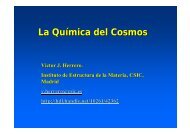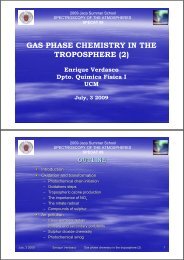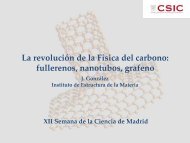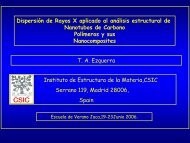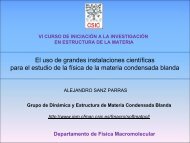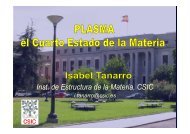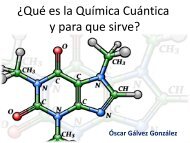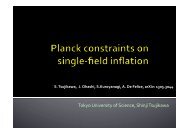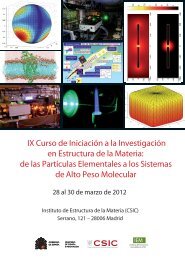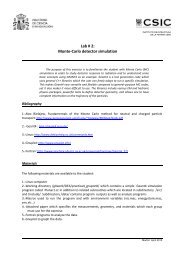ANNUAL REPORT 2011 - Instituto de Estructura de la Materia
ANNUAL REPORT 2011 - Instituto de Estructura de la Materia
ANNUAL REPORT 2011 - Instituto de Estructura de la Materia
Create successful ePaper yourself
Turn your PDF publications into a flip-book with our unique Google optimized e-Paper software.
oppositely aligned spins. This pairing gives rise to properties simi<strong>la</strong>r to superfluid helium and superconductivityresulting from paired electrons in con<strong>de</strong>nsed matter physics. In the structure that has been i<strong>de</strong>ntified in the pal<strong>la</strong>diumisotope 92 Pd, the neutrons and protons couple into a system of spin-aligned pairs, leading to completely differentproperties compared with what is found in ”normal” atomic nuclei. The interpretation of the experimental data hasbeen provi<strong>de</strong>d with the aid of microscopic nuclear shell mo<strong>de</strong>l calcu<strong>la</strong>tions. These calcu<strong>la</strong>tions suggest a completelydifferent picture for the heavy self-conjugate nuclei to what has been proposed in earlier theoretical mo<strong>de</strong>ls ofneutron-proton pairing. The results of this experiment have been published in <strong>2011</strong> in Nature (B. Ce<strong>de</strong>rwall et al.).MAGNETIC MOMENT MEASUREMENTS WITH STABLE (UNILAC, GSI) AND EXOTIC, NEUTRON-RICH (REX-ISOLDE) ION BEAMSMagnetic moments are a sensitive probe of single-particle properties in nuclei. They can be measured by observingthe perturbation introduced by a magnetic field on the angu<strong>la</strong>r corre<strong>la</strong>tion of gamma rays emitted in the <strong>de</strong>-excitationof the nuclear state of interest. Magnetic moment measurements were of paramount importance in the <strong>de</strong>velopmentof nuclear structure, and they were and are still essential to test the predictive power of the nuclear shell mo<strong>de</strong>l. In<strong>2011</strong> we published the results of state-of-the-art measurements of excited state magnetic moments in stable tinisotopes using the transient field technique (TF) in combination with Coulomb excitation in inverse kinematics (A.Jungc<strong>la</strong>us et al., PLB; J. Walker et al., PRC; J. Walker, PhD thesis, Universidad Autónoma <strong>de</strong> Madrid, May <strong>2011</strong>).The g factors of the first excited 2 + states in a series of Sn isotopes, <strong>de</strong>termined with unprece<strong>de</strong>nted precision,allowed to discriminate between a number of different mo<strong>de</strong>rn shell mo<strong>de</strong>l approaches and thus shed light on the<strong>de</strong>velopment of collectivity in the semi-magic chain of Sn isotopes.While the TF technique is well established in conjunction with stable ion beams the <strong>de</strong>velopment of radioactivebeams, while extending the domain of investigation to exotic nuclear realms very far from the line of stability, posenew experimental challenges. Our group accepted these challenges and inten<strong>de</strong>d to overcome certain inherentlimitations thanks to the construction of a new, purpose built, state-of-the-art reaction chamber, which was<strong>de</strong>veloped and built at IEM-CSIC. The new chamber harbors the external coils and yoke to produce the 80 mT fieldrequired to magnetize the ferromagnetic Gd target <strong>la</strong>yer and a liquid-nitrogen cooling circuit to keep its temperaturewell below the Curie temperature. In November <strong>2011</strong> A. Jungc<strong>la</strong>us, A. Il<strong>la</strong>na, A. Perea, J. A. Briz and R. Or<strong>la</strong>ndi, incol<strong>la</strong>boration with researchers from other European research institutes, run the first part of the experiment IS483 atREX-ISOLDE, CERN, aimed at measuring the magnetic moment of the first excited 2 + state in 72 Zn. The obtaineddata are currently being analyzed by A. Il<strong>la</strong>na in the frame of his PhD work and the experiment will be completedwith the remaining shifts in 2012. This pioneering measurement should permit to test the best avai<strong>la</strong>ble <strong>la</strong>rge-scaleshell mo<strong>de</strong>l calcu<strong>la</strong>tions which <strong>de</strong>scribe this region of the nuclear chart.REFLECTION ASYMMETRY IN LIGHT-ACTINIDE NUCLEI USING THE GAMMA-RAY TRACKINGARRAY AGATAReflection asymmetry and octupole <strong>de</strong>formation are well established nuclear properties and have been observed inmedium to heavy nuclei across the whole nuclear chart. On this topic, we participated in an experiment at theLaboratori Nazionali di Legnaro (Legnaro (PD), Italy) in March <strong>2011</strong> to characterize new structures observed in theoctupole-<strong>de</strong>formed light-actini<strong>de</strong> nuclei 220 Ra and 222 Th. The main goal of the experiment was to measure the linearpo<strong>la</strong>rization of gamma transitions linking new, unpublished rotational bands to the ground-state band. Thisexperiment ma<strong>de</strong> use of the AGATA <strong>de</strong>monstrator, an array of five triple cluster highly segmented germanium<strong>de</strong>tectors, which offers unprece<strong>de</strong>nted sensitivity, resolution and efficiency by exploiting its tracking capabilities.The gamma-ray interaction positions within the AGATA <strong>de</strong>tectors can be used to reconstruct the scattering angles ofthe transitions of interest, and hence <strong>de</strong>termine their linear po<strong>la</strong>rization. In this context it is also worth mentioningthat in <strong>2011</strong> the AGATA col<strong>la</strong>boration, the experimental nuclear physics group of the IEM is member of, reviewedall the achievements ma<strong>de</strong> in the AGATA project in recent years including all the necessary infrastructure to operateand support the spectrometer in an extensive (33 pages) article published in Nuclear Instruments and Methods A.R+D FOR THE R3B EXPERIMENT AT THE FUTURE FAIR FACILITYThe experiment R 3 B is part of the first phase of the FAIR facility. The experimental configuration of R 3 B is<strong>de</strong>signed for the <strong>de</strong>tection in complete kinematics of the products emitted in reactions at re<strong>la</strong>tivistic energies. TheCALorimeter for In-Flight gammA <strong>de</strong>tection (CALIFA) will be situated around the reaction target and should beable to reach the necessary angu<strong>la</strong>r and energy resolution to <strong>de</strong>tect gamma casca<strong>de</strong>s of 1 to 10 MeV with a strongDoppler broa<strong>de</strong>ning and Lorenz boost as well as to <strong>de</strong>tect protons of up to 300 MeV energy.Our R&D work concentrates on <strong>de</strong>velopments for the CALIFA gamma and proton spectrometer. We have within thecol<strong>la</strong>boration conclu<strong>de</strong>d the <strong>de</strong>sign of the Barrel part of the CALIFA calorimeter and a Technical Design Report(TDR) was, in December <strong>2011</strong>, han<strong>de</strong>d in to the FAIR management for evaluation.58




